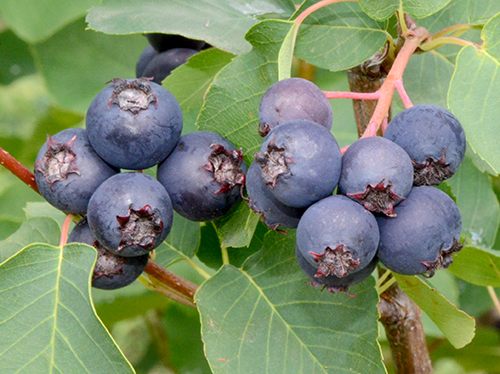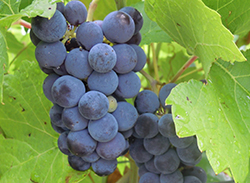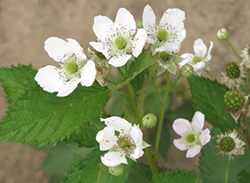
Considerations for growing backyard small fruit
DOWNLOADFebruary 1, 2018 - Duke Elsner
 The term “small fruit” applies to a wide array of fruiting plants. Essentially, any fruit crop that is not borne on trees is a small fruit. Growing backyard small fruit takes a commitment to soil preparation and multiple years of care before you can harvest a crop. Some small fruits double as attractive landscape plants. In addition to growing what you like to eat, select particular fruit types and cultivars based on the growing conditions, space availability, pest and disease susceptibility, and the time and effort you are willing to invest in growing small fruit.
The term “small fruit” applies to a wide array of fruiting plants. Essentially, any fruit crop that is not borne on trees is a small fruit. Growing backyard small fruit takes a commitment to soil preparation and multiple years of care before you can harvest a crop. Some small fruits double as attractive landscape plants. In addition to growing what you like to eat, select particular fruit types and cultivars based on the growing conditions, space availability, pest and disease susceptibility, and the time and effort you are willing to invest in growing small fruit.
The table in this tip sheet summarizes the plant size, soil conditions, winter hardiness and number of years before harvest for a number of traditional small fruits, plus a few novel types that have become of interest in recent years.

Saskatoon berries.
General considerations for growing backyard small fruit
 Most of the bush fruits require annual pruning, training and thinning of plant density to maintain a desired plant size and level of productivity. Left alone, they can out-grow their available spaces or become unproductive as they age. All grapes and many of the brambles are best grown on supportive trellises. Some fruit cultivars require different cultivars for cross-pollination.
Most of the bush fruits require annual pruning, training and thinning of plant density to maintain a desired plant size and level of productivity. Left alone, they can out-grow their available spaces or become unproductive as they age. All grapes and many of the brambles are best grown on supportive trellises. Some fruit cultivars require different cultivars for cross-pollination.- Most small fruits will require pesticide applications to control key pests and diseases to get useable fruit. Spotted wing Drosophila (SWD) is a tiny fruit fly that is particularly troublesome in several small fruits. Applying the principles of integrated pest management (IPM) will help maintain fruit quantity and quality while minimizing pesticide use.
 In general, small fruits require full sun (6-8 hours per day). Just a few hours a day of shade can negatively impact the rate of growth, fruiting potential and the cold hardiness of the plants. Carefully locate the planting site in the most exposed area of your property; consider removing shading trees to improve sun exposure.
In general, small fruits require full sun (6-8 hours per day). Just a few hours a day of shade can negatively impact the rate of growth, fruiting potential and the cold hardiness of the plants. Carefully locate the planting site in the most exposed area of your property; consider removing shading trees to improve sun exposure.- As long as there is good drainage, most small fruits do well in sandy loam to loamy soils with a slightly acid to neutral pH (6.0-7.0). Blueberries are a notable exception, as they absolutely require acidic soils (pH 4.5-5.5). Heavier clay soils are not ideal, unless drainage is improved. Improve soil drainage in poor sites by installing drain tiling, planting on berms or planting in raised beds.
 When irrigation is required, apply water only to the soil by means of trickle irrigation or soaker hoses. Any form of irrigation that wets the leaves, stems or fruits of the plant will greatly increase the risk of diseases.
When irrigation is required, apply water only to the soil by means of trickle irrigation or soaker hoses. Any form of irrigation that wets the leaves, stems or fruits of the plant will greatly increase the risk of diseases.- For most small fruits, in-row spacing needs to be about equal to or greater than the expected mature plant height to avoid row to row shading. Brambles (raspberries and blackberries) are an exception, as these are often raised in a close-spaced hedgerow system. Between-row spacing can be varied to accommodate equipment clearance needs or efficient space utilization, but it should not be less than the expected mature height.
 Winter cold temperatures may have an effect on the survival of fruit crops. Select fruit cultivars that are adapted to the winter hardiness zone of your setting. Tender cultivars can be attempted, but there may be challenging winter cold from time to time that may greatly reduce crop production or kill plants outright.
Winter cold temperatures may have an effect on the survival of fruit crops. Select fruit cultivars that are adapted to the winter hardiness zone of your setting. Tender cultivars can be attempted, but there may be challenging winter cold from time to time that may greatly reduce crop production or kill plants outright.- Planting small fruits on a gently sloped site where cold air can drain away will lessen frost and freeze damage to blossoms in spring and frost damage in fall. The slope direction can impact the sunlight exposure and temperature characteristics of sites. Northern- and eastern-facing slopes tend to be cooler and may delay ripening of fall-harvested fruits.
| Table 1. Some site and cultural considerations for growing small fruits. | |||||
|---|---|---|---|---|---|
| Small fruit | Mature sizes | Soil requirements, including pH | Winter hardiness | Years to first harvest | Other considerations (SWD = spotted wing Drosophila) |
| Strawberry—June bearing and everbearing | Less than 1 square foot per plant. | Well-drained sandy loams, high organic matter, 5.8-6.5 pH. | Provide winter protection—straw or row cover. Zones 4-8. | June bearing: 2 years. Everbearing: first year. | Numerous growing system options; can be grown in containers but not likely to fruit in hanging baskets. June bearing types may avoid SWD problems. |
| Raspberry | 3-5 feet tall and wide. | Well-drained sandy loam, 6.0-6.8 pH. | Most cultivars relatively hardy Zones 4-8. | 1-2 years | Summer bearing types are more complicated to manage and fruit in the second year, but have less risk of SWD. Fall bearing raspberries fruit in the first year. Some can be invasive. |
| Blackberry | 4-8 feet tall and wide. | Well-drained sandy loam, 6.5-6.8 pH. | Most cultivars are hardy to Zones 6-8; a few to Zone 5 or 4. | Most 2 years | Needs winter protection. Lay canes on ground; cover with snow or mulch for winter. ‘Illini Hardy,’ ‘Chester’ and ‘Natchez’ are some of the hardiest. Can be invasive. |
| Blueberry | 4-6 feet tall by 3-4 feet wide. | Sandy, well-drained soils, high organic matter, 4.5-5.5 pH (very acidic soil). | Most cultivars tolerate -15 F. Zones 4-7, some to Zone 3. | 3-4 years | All cultivars (especially late ones) are susceptible to SWD. |
| Grape | 5-6 feet tall by 4-10 feet along a trellis. | Sandy, well-drained soils, high organic matter, 5.5-6.5 pH. | Many cultivars Zones 5-8; some Minnesota hybrids Zone 3. | 3-4 years | Detailed annual pruning and plant support is required; does not require pollinating insects. Site selection is important to reduce frost damage. |
| Currant and gooseberry | 3-4 feet tall and wide. | Sandy to clay loam, well-drained soils, high organic matter, 6.0-6.5 pH. | Zones 3-5. Most cultivars tolerate -15 F. | 2-3 years | White pine blister rust-resistant cultivars are required in some areas. Look for mildew-resistant cultivars. |
| Saskatoon berry | 4-6 feet tall by 3-4 feet wide. | Loam to sandy loam, good drainage is very important, 5.5-7.0 pH. | Very cold hardy Zones 3-7. | 3-4 years | Very limited experience in eastern U.S. Good for landscape use. |
| Elderberry | 6-8 feet tall and wide. | Moist, fertile and well-drained soils, 5.5-6.5 pH. | Very hardy Zones 3-7. | 3-4 years | Requires cross-pollination with two cultivars. Used for juice, pies, jams, dried; flowers also used. |
| Honeyberry (Haskaps) | 2-4 feet tall by 3 feet wide. | Well-drained soils, 5.0-7.0 pH. | Moderately hardy Zones 3-8. | 2-3 years | Very limited experience in U.S. Needs two varieties for cross-pollination. |
| Chokeberry (Aronia berry) | 4-6 feet tall and wide. | Well-drained soils, 6.0-7.5 pH, tolerates partial shade. | Some cultivars are very hardy Zones 3-8. | 3-4 years | Used for tea, jam, syrup and juice—can be very astringent. Ripens mid-August to mid-September. |
| Goji berry | 2-4 feet tall by 3-4 feet wide. | Well-drained soils, 6.0-7.0 pH. | Many Zones 5-9, some to Zone 3. | 2-3 years | Very small berries, some cultivars thorny. Self-pollinating. |
This work is supported by the Crop Protection and Pest Management Program 2017-70006-27175 from the USDA National Institute of Food and Agriculture. Any opinions, findings, conclusions or recommendations expressed in this publication are those of the author(s) and do not necessarily reflect the view of the U.S. Department of Agriculture.



 Print
Print Email
Email





